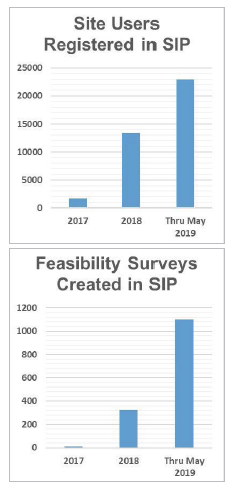Disruptive Innovation Drives Positive Outcomes
Best Practices for Adopting the Shared Investigator Platform
 The Cognizant Shared Investigator Platform – SIP – is the disruptive innovation our industry sorely needs to reduce the burden placed on sites conducting clinical trials.
The Cognizant Shared Investigator Platform – SIP – is the disruptive innovation our industry sorely needs to reduce the burden placed on sites conducting clinical trials.
Stakeholders from across the industry have expressed that sentiment to me countless times since I joined Cognizant six months ago as the product lead for SIP.
The need for a technology platform that unifies all stakeholders is clearly demonstrated in the recent SIP adoption metrics:
• More than 23,000 site users are now registered in SIP across 80 countries, and growing by thousands per month
• Two more large pharmaceutical sponsors went live on SIP this year, bringing the total to six, with more in the queue for the second half of 2019
• SIP is now officially available to all biopharmaceutical sponsors
• Large academic research and site management organizations are committing to SIP, now that the platform allows them to easily manage their networks of investigators and sites
The speed and scale of change that disruptive innovations such as SIP brings to industry stakeholders is significant. Because companies of different sizes have varying appetites for change, SIP is now consumable in many ways, providing flexibility for sponsor adoption. SIP can be used as a stand-alone technology platform, driving efficiency across processes such as feasibility, site selection, and training; or it can be leveraged across the enterprise. In the latter case, where SIP becomes integrated with other clinical systems such as CTMS and eTMF, organizational change management (OCM) is vital to drive the highest levels of efficiencies and time savings possible.
 Our experience shows beginning with a formal OCM Plan and Strategy leads to the most successful global implementations of SIP. Building in a Discovery Phase of several months allows your SIP Change Management team to gather knowledge across the global enterprise, understand its relationships with sites and technology providers, and establish best practices to advise the OCM plan for implementation.
Our experience shows beginning with a formal OCM Plan and Strategy leads to the most successful global implementations of SIP. Building in a Discovery Phase of several months allows your SIP Change Management team to gather knowledge across the global enterprise, understand its relationships with sites and technology providers, and establish best practices to advise the OCM plan for implementation.
Important components include:
Communications Planning – a month-by-month plan to communicate to all impacted stakeholders, especially sites and site-facing staff
Stakeholder Engagement Plan – ensuring that the voice of all impacted stakeholders is incorporated into SIP implementation, through interviews and surveys
Readiness Assessment – developing a long-term assessment of sponsor users’ readiness for SIP; measuring over time to gauge comfort and comprehension
Change Impact Analysis – analyzing all business processes impacted by SIP, understanding the changes to roles and risks created and developing action plans to mitigate risks
Project Metrics – measuring sponsor user adoption, training effectiveness, communications effectiveness
Benefits Realization – stemming from the business case for implementing SIP, developing a long-term plan and measuring the business benefits of adopting SIP (e.g. time between study startup milestones, financial savings)
Training Planning & Delivery – developing a training needs analysis, curricula and training plan to ensure that all roles impacted by SIP receive customized training for the skills and functions needed, delivered at the right time
To learn more about successful adoption of the Shared Investigator Platform, meet the SIP team in Booth 2221, and join my presentation with Summer Iverson of Pfizer on Monday, June 24, at DIA 2019.








